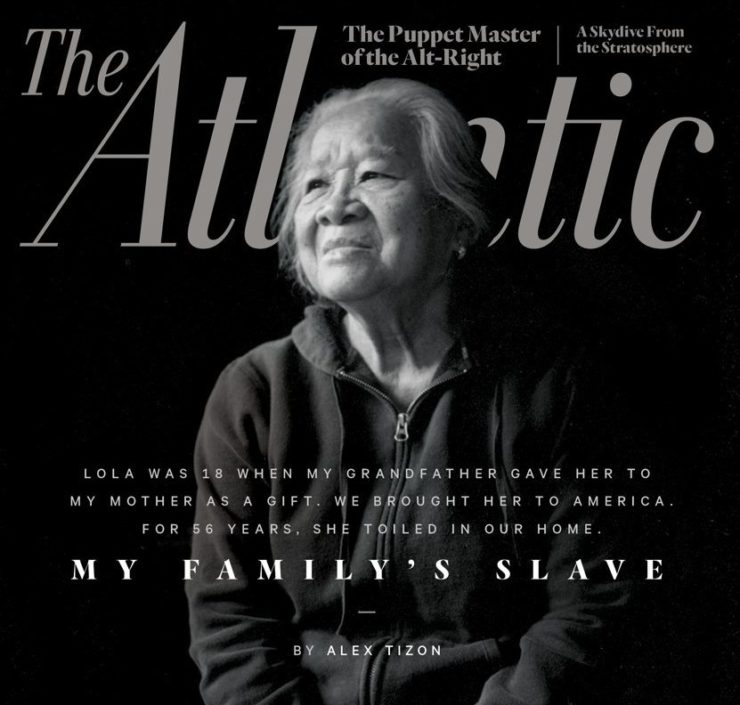The story of the woman called Lola begins and ends with ashes. Ashes that “filled a plastic box about the size of a toaster.” Ashes sheltered in a canvas tote bag from a suburb north of tech-hip Seattle to a rice-farming village deep in the poverty of the Philippines. Ashes finally buried with enduring love complicated by lifelong shame.
I also hope journalists don’t dismiss the chance to learn from “My Family’s Slave” – not just about a societal scourge, but about the level of talent and plain hard work it takes to bring those scourges to light.
Alex Tizon’s journey, as he carries those ashes home, provides the frame of a disturbing family memoir and a long-overdue homage to Eudocia Tomas Pulido, the woman he called, simply, Lola. She was his first memory, and his last byline. She was the secret he never told, and the story he said he was born to write. She was, as the June 2017 cover of The Atlantic so baldly stated, “My Family’s Slave.”
It is the saddest of ironies that Tizon didn’t live to see the publication of Lola’s story. His unexpected death in March, at 57, adds another layer to the narrative’s metaphor, but leaves him silent in the face of the fierce reaction it has inspired.
“My Family’s Slave” went viral as soon as it hit The Atlantic’s website. Fans declared it Pulitzer-worthy – a courageous confession that unveiled a necessary truth: Human enslavement remains a modern-day curse, sometimes masked or excused as cultural convention.
Others slammed it as an apologia absolving Tizon of responsibility in the face of his family’s shame: A destitute teenager had been “given” to his mother decades earlier in the Philippines in a lodging-for-labor swap. She toiled in the Tizons’ service for the nearly 60 years – unpaid, uneducated and seldom spoken of outside the family.
My own reaction to “My Family’s Slave” was clouded by a stew of emotions I’m still sorting out. I was Tizon’s editor for two years at The Seattle Times, although it felt more like piloting a wing-walker than editing. After we both moved on, we stayed close, sharing a passion for travel and teaching and books and the lonely struggles of writing and for stories that explore the mess and wonder of the human condition. On March 14 this year, I wrote a letter recommending him for tenure at the University of Oregon. On March 31, I wrote his eulogy.

I knew then that Tizon was writing a profile of Lola. Though I was as pained as anyone by what it revealed, I was thrilled to see it in print. The writing not only shone with mastery, but with a comfort of mastery that comes only after decades of self-doubt. I always knew Tizon as a gifted writer – as much a philosopher-poet-essayist as a straight-ahead journalist. But with this piece, following his exploration of race and identity in his 2014 memoir, “Big Little Man,” it seemed he had finally found the voice and calm he needed to face what haunted him.
Tizon spoke of Lola frequently, always with an intriguing combination of humor and reverence. I never fully understood where she fit in the family tree, and when I asked one time, he shrugged off my question, as he usually did when it came to his personal life. He simply said she was an older, distant relative who had always lived with their family, a not uncommon custom among Filipinos. Lola, after all, is a Tagalog term often used for “grandmother.” Seven years after her death, she remained an honored presence at his memorial service. One of Tizon’s sisters remembered asking why Lola’s death felt harder to bear than their mother’s. His response: “Because she was the best person we ever knew.”
After the story ran, I watched the attacks pile up on Twitter – many of them attacks on Tizon’s motives and integrity. I remain conflicted by a piece in The Seattle Times, which published what amounted to a correction on Pulido’s obituary, based on a lengthy interview with Tizon, calling it a lie of omission.
I don’t dismiss the outrage sparked by the revelations in “My Family’s Slave.” But I hope this doesn’t become an asterisk that overshadows the trove of a storied career, including a team project that won the 1997 Pulitzer Prize for investigative reporting.
Instead, I hope Tizon’s final story becomes the first chapter in a larger narrative. I’ve since read several thoughtful pieces by people inspired to reconsider their own family secrets. The Atlantic has built an archive of commentary, and is pursuing several follow-up stories on human trafficking and cultural slavery. And on Wednesday, the Gates Foundation is hosting a public discussion prompted by the story.
It is the saddest of ironies that Tizon didn’t live to see the publication of Lola’s story. His unexpected death in March, at 57, adds another layer to the narrative’s metaphor, but leaves him silent in the face of the fierce reaction it has inspired.
I also hope journalists don’t dismiss the chance to learn from “My Family’s Slave” – not just about a societal scourge, but about the level of talent and plain hard work it takes to bring those scourges to light. Tizon was a woodworker as well as a writer. You might not like the piece he built, but the construction is nearly flawless.
Consider the story’s craft:
The writing is deceptively simple. Tizon gets out of the story’s way, delivering his most dramatic material with understatement. He uses few complex sentences; no fussy words; easy markers that let readers know where they are in time and place.
The narrative is carefully polished, yet suggests the intimacy of a one-to-one conversation. Read Tizon’s piece aloud. You will hear the story he is telling. Read it a second time for rhythm. The cadence is coherent but not staccato. Longer sentences are punctuated by short, with the shorter ones carrying more weight.
“We never talked about Lola.”
“She often slept among piles of laundry.”
“I had a family, a career, a house in the suburbs – the American dream. And then I had a slave.”
The structure is cinematic. Tizon uses words the way a filmmaker uses a camera. He zooms in close on crucial scenes, letting us hear Lola’s wails and his father’s derision, letting us see Lola try to chew with her crumbled teeth. He pulls back to place the specific story into the larger context of culture and history. Along the way, he puts us in the taxi as he winds his way to Lola’s village, like a camera panning to show passage of time or distance.
Tizon employs a few other tools that are more subjective. They leave his searing piece open to equally searing debate because they put him in control not just of the story’s telling, but of its very meaning.
He climbs up and down the ladder of abstraction. The story is built of concrete words and scenes, but is really probing universal life themes – human feelings we all experience even if our literal experiences are far different.
Mashing food for a sick child? Disgusting drudgery. Or maybe deep devotion.
Enduring a beating for someone else’s crimes? Powerlessness. Or maybe a deep well of defiance.
Called by a name that is more a status than a name? Inferiority. Or maybe honor.
And that cheap plastic box filled with Lola’s ashes? Regret. Shame. Penance. Love. A promise failed and a promise kept. Pretty much the entire circle of a life, ashes to ashes.
That same approach allows Tizon to blend moments of light amid the dark, adding readability and authenticity. His mother was guilty of monstrous behavior, but was not a complete monster. Lola’s life was steeped in torment, but was not without laughter or love.
I knew that Tizon was writing a profile of Lola. Though I was as pained as anyone by what it revealed, I was thrilled to see it in print. The writing not only shone with mastery, but with a comfort of mastery that only comes only after decades of self-doubt.
I’m not surprised that some readers wanted this story to climb to a different place on the ladder than Tizon took it. Just as he failed to rescue Lola from his parents’ brutality, he failed to deliver an investigation into cultural servitude. Wouldn’t we all applaud a tale that left Lola standing as a noble survivor, or had a happier ending? Or maybe some readers thought the ending was too happy by far – too much a trick of writerly craft that wrapped things into a neat bow – while they were left standing at the edge of a road they didn’t anticipate, with darker questions and darker paths ahead.
Journalism is obsessed, these days, with metrics. Narratives tend to defy those calculations; there are no metrics to measure the impact on the human heart. Tizon’s story, on its own, did not change laws or close down systemic corruption. But perhaps it will do something even more important, which is to open our eyes to people who often go unseen.
The unseen person in “My Family’s Slave” is Lola. And at first glance, the story purports to be hers. We are taken through the chronology of her life. We wince as we witness her abuse. We want to cradle her when she cowers, and again when she is carried in laughter to the driver’s seat of a car, and again when she is placed on a gurney, and finally when her ashes are brought home to rest. But for all that, we don’t ever fully understand what life felt like for her. She looks out from the cover of The Atlantic, in a haunting and beautiful portrait by Alan Berner of The Seattle Times. But even then, she looks off into the distance, at something we can’t see. She doesn’t look at us. For all we know about her, we never really know her.
That distance from Lola runs through the harshest of rebukes leveled at Tizon’s story. Some thought that “My Family’s Slave” diminished Eudocia Tomas Pulido one more time. That even as Tizon finally brought her out of the shadows of his family’s secret, she was never given more standing than to be his Lola.
I read this story differently. Maybe because my reading is colored by my deep affection for Tizon and my abiding grief at his death. Maybe because for years I watched his struggle to unspool the true story of Lola to his friends, and then to unspool that truth in a written piece. Maybe because, in that written piece, I still read his struggle to discover who she really was.
They say every true narrative is a journey, and inside the journey is a quest. The journey Tizon takes us on is his. As is the quest, one desperate to come to terms with how his life with Lola touched and tormented and, finally, graced him.



